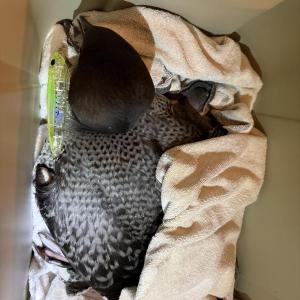Loon tangled in fishing gear, multiple hooks embedded in body, is rescued on Hosmer Pond in Camden
 The loon is rescued and transported to York for medical care. (Photo courtesy Dominic Gioia)
The loon is rescued and transported to York for medical care. (Photo courtesy Dominic Gioia)
 The lure that the loon suffered. (Photo courtesy Dominic Gioia)
The lure that the loon suffered. (Photo courtesy Dominic Gioia)
 Hosmer Pond, Camden, has fish, ducks, loons, turtles and other wildlife sharing the environment. (Photo by Lynda Clancy)
Hosmer Pond, Camden, has fish, ducks, loons, turtles and other wildlife sharing the environment. (Photo by Lynda Clancy)
 Look Out for Loons on Hosmer Pond. The warnings are clearly stated.
Look Out for Loons on Hosmer Pond. The warnings are clearly stated.
 Hosmer Pond, Camden, has fish, ducks, loons, turtles and other wildlife sharing the environment. (Photo by Lynda Clancy)
Hosmer Pond, Camden, has fish, ducks, loons, turtles and other wildlife sharing the environment. (Photo by Lynda Clancy)
 Hosmer Pond, Camden, has fish, ducks, loons, turtles and other wildlife sharing the environment. (Photo by Lynda Clancy)
Hosmer Pond, Camden, has fish, ducks, loons, turtles and other wildlife sharing the environment. (Photo by Lynda Clancy)
 Hosmer Pond, Camden, has fish, ducks, loons, turtles and other wildlife sharing the environment. (Photo by Lynda Clancy)
Hosmer Pond, Camden, has fish, ducks, loons, turtles and other wildlife sharing the environment. (Photo by Lynda Clancy)
 Loon after healing from wounds is carried back to Hosmer Pond for release. (Photo courtesy Dominic Gioia)
Loon after healing from wounds is carried back to Hosmer Pond for release. (Photo courtesy Dominic Gioia)
 The loon is rescued and transported to York for medical care. (Photo courtesy Dominic Gioia)
The loon is rescued and transported to York for medical care. (Photo courtesy Dominic Gioia)
 The lure that the loon suffered. (Photo courtesy Dominic Gioia)
The lure that the loon suffered. (Photo courtesy Dominic Gioia)
 Hosmer Pond, Camden, has fish, ducks, loons, turtles and other wildlife sharing the environment. (Photo by Lynda Clancy)
Hosmer Pond, Camden, has fish, ducks, loons, turtles and other wildlife sharing the environment. (Photo by Lynda Clancy)
 Look Out for Loons on Hosmer Pond. The warnings are clearly stated.
Look Out for Loons on Hosmer Pond. The warnings are clearly stated.
 Hosmer Pond, Camden, has fish, ducks, loons, turtles and other wildlife sharing the environment. (Photo by Lynda Clancy)
Hosmer Pond, Camden, has fish, ducks, loons, turtles and other wildlife sharing the environment. (Photo by Lynda Clancy)
 Hosmer Pond, Camden, has fish, ducks, loons, turtles and other wildlife sharing the environment. (Photo by Lynda Clancy)
Hosmer Pond, Camden, has fish, ducks, loons, turtles and other wildlife sharing the environment. (Photo by Lynda Clancy)
 Hosmer Pond, Camden, has fish, ducks, loons, turtles and other wildlife sharing the environment. (Photo by Lynda Clancy)
Hosmer Pond, Camden, has fish, ducks, loons, turtles and other wildlife sharing the environment. (Photo by Lynda Clancy)
 Loon after healing from wounds is carried back to Hosmer Pond for release. (Photo courtesy Dominic Gioia)
Loon after healing from wounds is carried back to Hosmer Pond for release. (Photo courtesy Dominic Gioia)
Editor's note: Dominic Gioia is a Camden resident and was recently part of a rescue effort of a juvenile loon on Hosmer Pond, in Camden. Besides being wrapped in heavy fishing line, the loon had multiple fishing hooks embedded in it, and was close to perishing.
Hosmer Pond, at the foot of Ragged Mountain, is accessed by a public boat launching area that has become popular for fishing. With that, there has been an increase of discarded fishing lures, hooks and lines along the shore and in hidden in the weeds. A neighbor who lives across the street from Hosmer Pond has a large bowl that is filled with such fishing gear, all which he has collected by cleaning the shoreline of the freshwater pond.
Wing Goodale, a wildlife biologist at Biodiversity Research Insititute, lead the rescue of the loon. BRI is permitted to capture and transport loons.
After being rescued and spending time at the Wildlife Medicine and Nature Center in York (where even more hooks, four of them, were found embedded in the bird), the loon survived and is back on the pond with other loons. Gioia said he heard him calling with the other loons just the other day. But the problem remains: Fish hooks and lead jigs and sinkers are dangerous to wildlife. This loon's story is evidence of just that.
By Dominic Gioia
On Tuesday, September 2, my son, uncle, and I were walking the dog over to the Snow Bowl boat launch and my son wanted to do a little fishing.
When we were down there around 9 a.m. we decided to go out to the sandbar bar to the right of the boat launch. Out there we noticed two loons. It looked like an adult and the juvenile from this year. The smaller one started to swim up to me. I commented on how that was strange.
When it got closer, I was surprised to see something green on its neck. I thought that he might have some sort of tag on him. Then when he got even closer I noticed it was a lure. He continued to swim up to me. I was still on the shore and he wouldn’t come out of the water.
I then remembered how loons can’t really walk. He swam back out.
I took off my shoes and socks and walked in the water a bit and tried to call him back over. To my surprise, he came back over to me.
I reached out to try to remove the hook, but once I touched it he got spooked so I let him go.
The lure, approximately six inches long, had two large stainless steel treble hooks on it. One was lodged in his beak with some blood showing, the other in his neck. The hook was also wrapped in fishing line.
I called the game warden dispatch and told them the story. The game warden called me back about 15 minutes later and said he would go and find the loon. At this point I thought my role in this story was over and I continued on my day as planned.
Now fast-forward to 7:30 p.m. that evening. My wife, Liz, got a phone call from Marie Goodale saying that her husband Wing were at the pond doing a loon rescue and asked if we had a canoe that Wing could borrow.
Liz told them that I had found the loon that morning and had called the Inland Fisheries and Wildlife. My uncle and I grabbed my canoe and headed over to the pond. When we got down there, Wing was already out looking for the loon in a borrowed kayak from someone else in the pond. We decided to wait and see if he had any luck.
I told Marie that the loons had a nest on the small island this spring and she let Wing know. It was now starting to get dark and we had not heard any updates so my Uncle Don and I decided to go out in the pond to see what was going on.
In a short distance, we saw Wing and headed towards him. He was heading north on the far side of the pond. When we got close to him I asked if he had found the loon. He said he had just located it and that it was sitting on a swimming pad anchored directly across from the boat launch.
He had paddled almost the full circumference of the pond before he found him. He started to approach the loon very slowly and I informed him that I was going to stand back unless he called for me, because I didn’t want to get in the way of a professional or even worse, scare the loon.
Once he was about six to 10 feet away, Wing took out an extendable net and put it over the loon. It was too dark for me to see what was happening at this point but I could hear splashing. Wing then yelled for me to come help.
We paddled over and I helped him rangle the panicked loon into his kayak between his legs. He then put a towel over the loon's head, which calmed him down somewhat. But, he still had to hold the loon down because the bird did not want to be in that kayak. I'm positive that Wing did not want that loon to try to attack him to get free while he between his legs, of all places.
I then took Wing's paddle and net, as well as his his tow-line so we could tow him back to his friend's dock on the other side of the pond. Once back to the dock, Marie and their son, Cedar, were waiting for us. I got out of my canoe and Wing instructed me to hold the loon down by the back while holding his legs to transfer the bird to the dock.
Wing told me that if a loon bites, it is likely to not pull away because loons have a barbed beak. Things will get bad if that happens.
Luckily, I didn’t have to use his advice because the loon did not try to bite me. Once we made the transfer and I was holding down the loon on the dock, Wing was able to come ashore and examine the loon.
The treble hook was no longer in its beak but had been lodged into the side on his lower wing, while the other was still in his neck.
Unfortunately, the hooks were no longer visible. The lure was now positioned that every time he moved it just dug them in farther and farther. They were were fully imbedded and there was visible blood on his neck and lower wing.
There was also about 50-75 feet of at least 65-pound-test fishing line wrapped around the loon's neck, feet, body, and dragging along behind it. Wing cut off the loose fishing line and we decided that the loon needed to go to a clinic.
We could not attempt to pull the hooks out here without hurting the loon further and hurting ourselves.
Marie and Cedar retrieved a plastic tote from the car, and Wing and I did a joint lift of the loon into the tote, Wing holding the beak and me, the body.
The poor bird was in a pretty sorry state.
Since it was almost 9 p.m. and pitch black out, he took the loon home in the tote with his family.
Later that night, Wing sent me as text saying he cut the two treble hooks off the lure so the loon could be a little more comfortable for the night and that he would be transporting it to a Avian rehab facility down in York Maine the next day.
For anyone who doesn’t know, a treble hook is actually made up of three hooks, like a grappling hook, with a barb on the end of each hook. On this lure each hook was over an inch long.
So the loon had three hooks in his neck and three hooks in his lower wing. Since they were attached to one long lure every time the loon bent his neck or moved his wing the hooks would either dig in deeper or like when we finally retrieved the loon since they were imbedded as far as they could go at this point, tear at his flesh.







































